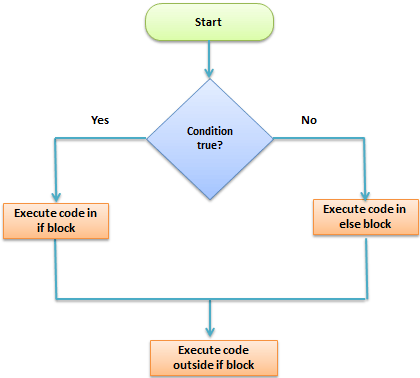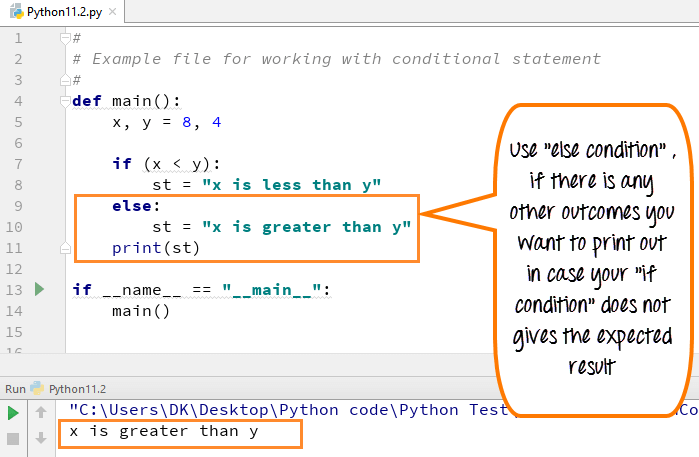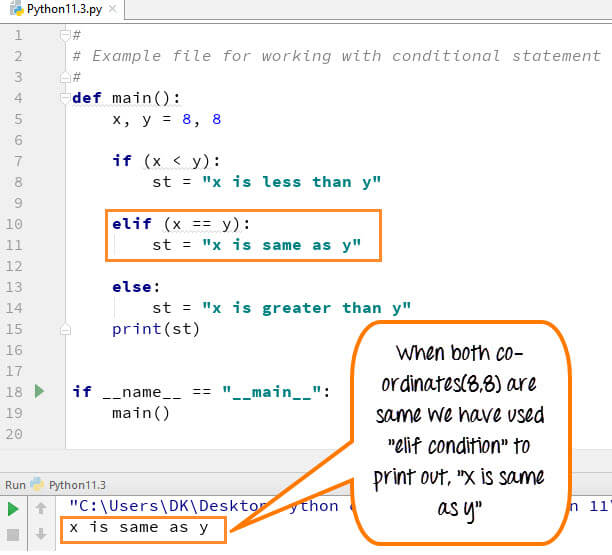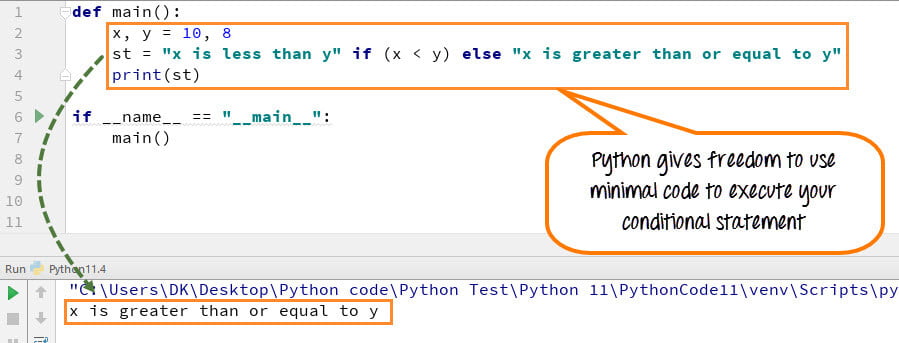Pythonの条件文は何ですか?
Pythonの条件文は、特定のブール制約がtrueまたはfalseに評価されるかどうかに応じて、異なる計算またはアクションを実行します。 条件文はPythonのIF文によって処理されます。 このチュートリアルでは、Pythonで条件文を適用する方法を見ていきます。
- If文とは何ですか? それを使用する方法か。
- “if条件”が満たされていないときに何が起こるか
- “else条件”を使用する方法
- “else条件”が動作しないとき
- “elif”条件を使用する方法
- 最小限のコードで条件文を実行する方法
- Pythonのネストされたif文
- PythonのSwitch Case文
Python If文とは何ですか?
Python If文は、意思決定操作のために使用されます。 これには、if文で指定された条件がtrueの場合にのみ実行されるコード本体が含まれています。 条件がfalseの場合、else条件のコードを含むオプションのelseステートメントが実行されます。他の条件が真ではない間に1つの条件を正当化したい場合は、Python if else文を使用します。
Python If文の構文:
if expression Statementelse Statement
Python if。..elseフローチャート

Pythonのif else文の例を見てみましょう: P>

##Example file for working with conditional statement#def main():x,y =2,8if(x
- コード行5:二つの変数x、y=2、8を定義します
- コード行7:Pythonのif文は条件xをチェッこの場合にtrueであるy
- コード行8:変数stは”Xはyより小さい”に設定されています。
- コード行9: Line print stは変数stの値を出力します。”x is less than y”,
“if condition”が満たされていないときに何が起こるか
このステップでは、Pythonのif conditionが満たされていないときに何が起こるかを見ていきます。 Pythonの条件文:IF、ELIF、ELSEネストされたIF
- コード行5:二つの変数x、y=8、4を定義します
- コード行7:Pythonのif文は条件xをチェックします<yこれケース
- コード行8: 変数stが”x is less than y”に設定されていません。
- コード行9:行print st-宣言されていない変数の値を出力しようとしています。 したがって、エラーが発生します。
“else条件”の使い方
“else条件”は、通常、他の文に基づいて1つの文を判断する必要がある場合に使用されます。 ある条件がうまくいかない場合は、文または論理を正当化する別の条件があるはずです。
例:

##Example file for working with conditional statement#def main():x,y =8,4if(x
- コード行5:二つの変数x,y=8,4を定義します
- コード行7:Pythonのifステートメントは条件xをチェックします<yこれはこの場合にはFalseです
- コード行9:プログラム制御のフローはelse条件になります
- コード行9:プログラム制御の流れはelse条件になります
- コード行9:プログラム制御の流れはelse条件になります
- コード行10:変数stは”xはyより大きい”に設定されています。
- コード行11: Line print stは、”x is greater than y”である変数stの値を出力します。
“else condition”が機能しない場合
“else condition”が目的の結果を得られない場合が多いかもしれません。 プログラムロジックに誤りがあるため、間違った結果が出力されます。 ほとんどの場合、これは、プログラム内で2つ以上の文または条件を正当化する必要がある場合に発生します。
例は、この概念を理解するのに役立ちます。 ここで、両方の変数は同じ(8,8)であり、プログラム出力は”xはyより大きい”ですが、これは間違っています。 これは、最初の条件(Pythonのif条件)をチェックし、失敗した場合は2番目の条件(else条件)をデフォルトとして出力するためです。 次のステップでは、このエラーをどのように修正できるかを確認します。 Pythonの条件文:IF、ELIF、ELSEネストされたIF
##Example file for working with conditional statement#def main():x,y =8,8if(xHow to use "elif" condition
To correct the previous error made by "else condition", we can use "elif" statement. By using "elif" condition, you are telling the program to print out the third condition or possibility when the other condition goes wrong or incorrect.
Example
Python Conditional Statements: IF, ELIF, ELSE Nested IF
##Example file for working with conditional statement#def main():x,y =8,8if(x
- コード行5:二つの変数x、y=8、8を定義します
- コード行7:if文は条件xをチェックします

##Example file for working with conditional statement#def main():x,y =8,8if(x
How to use "elif" condition
To correct the previous error made by "else condition", we can use "elif" statement. By using "elif" condition, you are telling the program to print out the third condition or possibility when the other condition goes wrong or incorrect.
Example
 Python Conditional Statements: IF, ELIF, ELSE Nested IF
Python Conditional Statements: IF, ELIF, ELSE Nested IF##Example file for working with conditional statement#def main():x,y =8,8if(x
- コード行5:二つの変数x、y=8、8を定義します
- コード行7:if文は条件xをチェックします
##Example file for working with conditional statement#def main():x,y =8,8if(x
How to use "elif" condition
To correct the previous error made by "else condition", we can use "elif" statement. By using "elif" condition, you are telling the program to print out the third condition or possibility when the other condition goes wrong or incorrect.
Example
 Python Conditional Statements: IF, ELIF, ELSE Nested IF
Python Conditional Statements: IF, ELIF, ELSE Nested IF##Example file for working with conditional statement#def main():x,y =8,8if(x
<yこの場合はfalseです
- コード行10: プログラム制御の流れはelseif条件になります。 X==yがtrueであるかどうかをチェックします
- コード行11:変数stは”x is same as y”に設定されています。
- コード行15:プログラム制御のフローは、if文を終了します(else文には到達しません)。 出力は正しい”xはyと同じです”です
最小限のコードで条件文を実行する方法
このステップでは、条件文を凝縮する方法を見ていきます。 各条件のコードを個別に実行する代わりに、単一のコードでそれらを使用できます。
構文
A If B else C
例:

def main():x,y = 10,8st = "x is less than y" if (x
- コード行2:2つの変数x、y=10、8を定義します
- コード行3:変数stは、x<yの場合、”x is less than Y”に設定されます。 このx>y変数stは”x is greater than or equal to y.”に設定されています。
- コード行4:stの値を出力し、正しい出力を与えます
-
条件文の長いコードを書く代わりに、Pythonは短く簡潔な方法でコードを書く自由を与えます。
Pythonのネストされたif文
次の例は、pythonのネストされたif文を示しています
total = 100#country = "US"country = "AU"if country == "US": if total
Uncomment Line 2 in above code and comment Line 3 and run the code again
Switch Case Statement in Python
What is Switch statement?
A switch statement is a multiway branch statement that compares the value of a variable to the values specified in case statements.
Python language doesn’t have a switch statement.
Python uses dictionary mapping to implement Switch Case in Python
Example
function(argument){ switch(argument) { case 0: return "This is Case Zero"; case 1: return " This is Case One"; case 2: return " This is Case Two "; default: return "nothing"; };};Pythonで上記のスイッチケースのために
def SwitchExample(argument): switcher = { 0: " This is Case Zero ", 1: " This is Case One ", 2: " This is Case Two ", } return switcher.get(argument, "nothing")if __name__ == "__main__": argument = 1 print (SwitchExample(argument))Python2の例
上記のコードはPython3の例であり、Python2で実行したい場合は、次のコードを検討してください。 p>
# If Statement #Example file for working with conditional statement#def main():x,y =2,8if(x
Summary:
A conditional statement in Python is handled by if statements and we saw various other ways we can use conditional statements like Python if else over here.
- “if condition”–条件のいずれかがtrueまたはfalseの場合に結果を出力する必要がある場合に使用されます。
- “else condition”-一つの条件が要件を満たさなかったときにステートメントを出力したいときに使用されます
- “elif condition”–結果として第三の可能性があるときに使 あなたは、コード内の4番目、5番目、6番目の可能性をチェックするために、複数のelif条件を使用することができます
- 我々は、コードを実行するために、単一の文